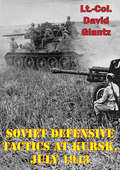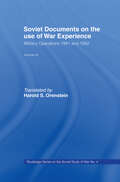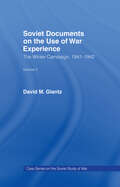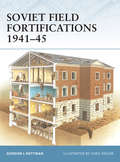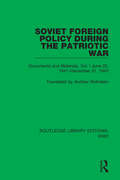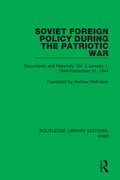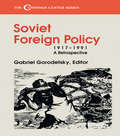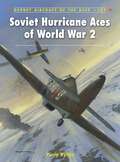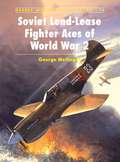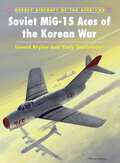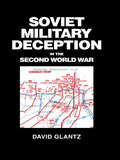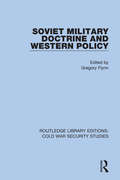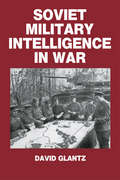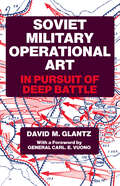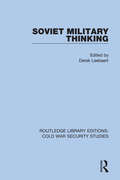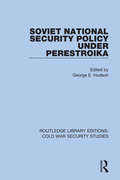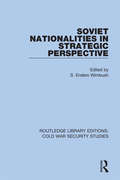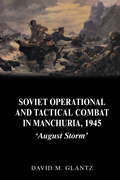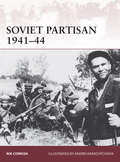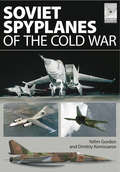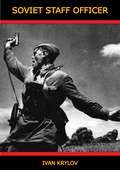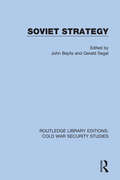- Table View
- List View
Soviet Defense Against Operation Barbarossa: A Possible Model For Future Soviet Defensive Doctrine
by Major Terry B. WilsonThis monograph examines the historic attack by Adolf Hitler's Germany against the Soviet defenses in 1941. It examines actions of both armed forces to analyze what went wrong and what went right for each side. It focuses on Soviet defenses to determine the usefulness of defensive planning and operations of 1941 to today's announced policy of reasonable sufficiency and non-offensive defense. The monograph begins with an analysis of current Soviet military doctrine and President Gorbachev's stated political ideal of 'reasonable sufficiency' and his goal for the military of a doctrine of 'non-offensive defense.' The monograph continues with an examination of Soviet military theory, an historical analysis of Operation Barbarossa, and an analysis of the usefulness of the campaign for modern doctrinal development. The Soviets use historical models in the scientific development of their doctrine.
Soviet Defensive Tactics At Kursk, July 1943
by Colonel David M GlantzIn his classic work, On War, Carl von Clausewitz wrote, "As we shall show, defense is a stronger form of fighting than attack." A generation of nineteenth century officers, nurtured on the study of the experiences of Napoleon and conditioned by the wars of German unification, had little reason to accept that view. The offensive spirit swept through European armies and manifested itself in the regulations, plans, and mentality of those armiehe events of 1939, 1940, and 1941 in Poland, France, and Russia respectively again challenged Clausewitz' claim of the superiority of the defense and prompted armies worldwide to frantically field large armored forces and develop doctrines for their use. While blitzkrieg concepts ruled supreme, it fell to that nation victimized most by those concepts to develop techniques to counter the German juggernaut. The Soviets had to temper a generation of offensive tradition in order to marshal forces and develop techniques to counter blitzkrieg. In essence, the Soviet struggle for survival against blitzkrieg proved also to be a partial test of Clausewitz' dictum. In July 1943, after arduous months of developing defensive techniques, often at a high cost in terms of men and material, the Soviets met blitzkrieg head-on and proved that defense against it was feasible. The titanic, grinding Kursk operation validated, in part, Clausewitz' views. But it also demonstrated that careful study of force organization and employment and application of the fruits of that study can produce either offensive or defensive victory. While on the surface the events of Kursk seemed to validate Clausewitz' view, it is often forgotten that, at Kursk, the Soviets integrated the concept of counteroffensive into their grand defensive designs. Thus the defense itself was meaningless unless viewed against the backdrop of the renewed offensive efforts and vice versa. What Kursk did prove was that strategic, operational, and tactical defenses could counter blitzkrieg.
Soviet Documents on the Use of War Experience: Volume Three: Military Operations 1941 and 1942 (Soviet (Russian) Study of War)
by Harold S. Orenstein David M. GlantzThe Soviet Study of War" series examines the lessons Soviet military theorists and commanders learned from the study of their own military experience. These are translations of Soviet documents.
Soviet Documents on the Use of War Experience: Volume Two: The Winter Campaign, 1941-1942 (Soviet (Russian) Study of War)
by Harold S. OrensteinThe Soviet Study of War" series examines the lessons Soviet military theorists and commanders learned from the study of their own military experience. These are translations of Soviet documents.
Soviet Field Fortifications 1941-45
by Gordon Rottman Chris TaylorFrom June 1941, the Soviets were forced to undertake large-scale defensive operations in the face of the overwhelming German blitzkrieg assault, operations which ran counter to their preference for highly mobile, offensive warfare. Lessons were quickly learned across a wide variety of terrain and climates, including the open steppes, dense forests, wooded swamps, cities, and in snow and ice, where the availability of construction materials differed greatly. The first to cover this topic in the English language and containing detailed information about the trenches, bunkers, observation posts, and weapon positions, this book examines field fortifications built from local materials by infantrymen, as well as their use of mines, field camouflage techniques, and construction tools. It provides a first fascinating insight into Russian defensive attempts against the overwhelming might of the German Army.
Soviet Foreign Policy During the Patriotic War: Documents and Materials. Vol. I June 22, 1941–December 31, 1943 (Routledge Library Editions: WW2 #30)
by Andrew RothsteinThis book, first published in 1946, collects documents illustrating the foreign policy of the Soviet Union during the Second World War. They show how the fighting alliance of the USSR, Britain and the USA came into being and grew stronger, how relations were restored with other anti-Nazi countries, and how diplomatic relations were extended between the USSR and hitherto un-connected countries. The collection of three parts of translated documents: statements and speeches made by Stalin; documents, treaties, agreements; appendices including press statements and telegrams.
Soviet Foreign Policy During the Patriotic War: Documents and Materials. Vol. II January 1, 1944–December 31, 1944 (Routledge Library Editions: WW2 #31)
by Andrew RothsteinThis book, first published in 1946, collects documents illustrating the foreign policy of the Soviet Union during the Second World War. They show how the fighting alliance of the USSR, Britain and the USA came into being and grew stronger, how relations were restored with other anti-Nazi countries, and how diplomatic relations were extended between the USSR and hitherto un-connected countries. The collection of three parts of translated documents: statements and speeches made by Stalin; documents, treaties, agreements; appendices including press statements and telegrams.
Soviet Foreign Policy, 1917-1991: A Retrospective (Cummings Center Series)
by Gabriel GorodetskyA comprehensive assessment of Soviet relations with the West, set in the context of the emergence of a new Russia. This volume anlayzes the formulation of foreign policy during the period from the first decade of the Bolshevik Revolution, through the gradual erosion of ideological differences.
Soviet Hurricane Aces of World War 2
by Aleksander Rusinov Yuriy RybinFollowing the destruction wrought on the Red Army Air Forces during the first days of Operation Barbarossa in June 1941, the Soviet Union found itself desperately short of fighter aircraft. Premier Josef Stalin duly appealed directly to Prime Minister Winston Churchill for replacement aircraft, and in late 1941 the British delivered the first of 3360 Hurricanes that would be supplied to the Soviet Union under the Lend-Lease agreement. Specifically requested by the USSR, the Hurricanes were quickly thrown into action in early 1942 - the Soviet Air Forces' most difficult year in their opposition to the Luftwaffe. Virtually all the Hurricanes were issued to Soviet fighter regiments in the northern sector of the front, where pilots were initially trained to fly the aircraft by RAF personnel that had accompanied the early Hawker fighters to the USSR. The Hurricane proved to be an easy aircraft to master, even for the poorly trained young Soviet pilots, allowing the Red Army to form quickly a large number of new fighter regiments in the polar area. In spite of a relatively poor top speed, and only a modest rate-of-climb, the Hurricane was the mount of at least 17 Soviet aces.
Soviet Lend-Lease Fighter Aces of World War 2
by George MellingerBy the end of 1941 the Soviet Union was near collapse and its air force almost annihilated, leaving large numbers of surviving pilots with no aircraft to fly. At this juncture the United Kingdom put aside its prewar animosities toward the Communists and despatched several hundred Hurricane fighters despite the fact that at this time the British were still struggling to supply the RAF with modern fighters in North Africa and the Far East. A total of 4300 Hurricanes and Spitfires, as well as several hundred Tomahawks, Kittyhawks and Airacobras, obtained from the USA under Lend-lease, were eventually supplied to the USSR in an attempt to present a Russian defeat. After the United States had entered the war, the Americans extended Lend-lease to include direct supply to the Soviets as well as the British, and among the aircraft sent were almost 10,000 fighters - mainly P-39s, P-40s and P-63s. Although many of these aircraft were outdated when they arrived, and some were not particularly suited to Russian operating conditions, they served when they were needed. A number of Russian pilots became Heroes of the Soviet Union flying Lend-lease aircraft, and many more gained their early experience before converting to their own Yaks and Lavochkins. All of these types, including the Hurricane, remained in active units until the end of the war, and even into the post-war period. The Soviet government tried to play down or conceal the importance of Lend-lease fighters until well into the 1980s, and the pilots who flew them were discriminated against as 'foreigners'. Only in recent years have these pilots felt free to admit what they flew, and now the fascinating story of these men and their heroic achievements can emerge.
Soviet MiG-15 Aces of the Korean War
by Leonid Krylov Yuriy TepsurkaevThe Soviet Union began assisting the People's Republic of China in its establishment of a modern air force in 1950, when Soviet Air Force regiments were sent to train local pilots. China's involvement in the Korean War in late October 1950 inevitably drew Soviet pilots into the war. A total of 52 Soviet pilots scored five or more victories in the Korean War. The history of these covert actions has been a long-buried secret and this book will be the first English publication to detail the only instance when the Cold War between Russia and the US became "hot." This book uncovers Soviet combat experiences during the Korean War from detailed unit histories and rare first-hand accounts. With access to extensive Russian archives, the authors offer an enthralling insight into an air war that has been largely covered up and neglected, illustrated with previously unpublished photographs and detailed full-color profiles.
Soviet Military Deception in the Second World War (Soviet (Russian) Military Theory and Practice #Vol. 1)
by David M. GlantzPublished in 1989, Soviet Military Deception in the Second World War is a valuable contribution to the field of Military & Strategic Studies.
Soviet Military Doctrine and Western Policy (Routledge Library Editions: Cold War Security Studies #49)
by Gregory FlynnThis book, first published in 1989, analyses Western and Soviet perceptions of each other’s military thoughts and doctrines, a key part of the Cold War, where both sides planned to both win a possible conflict, and to avoid one. The work demonstrates that both East and West made judgments about each other’s military profile on the basis of political preconceptions.
Soviet Military Intelligence in War (Soviet (Russian) Military Theory and Practice)
by Colonel David GlantzThis text is the second of three volumes written by Colonel Glantz on the contribution of intelligence and deception operations to the Soviet victory over Nazi Germany. It examines the area where intelligence and operations overlap; the nature of co-ordination between the two; and the support provided by intelligence to operational planning and execution (or the absence of such support). This is not a study of intelligence work as such, but of how intelligence can improve the chances of success on the battlefield by facilitating the more effective and economical use of troops.
Soviet Military Operational Art: In Pursuit of Deep Battle (Soviet (Russian) Military Theory and Practice)
by Colonel David GlantzDavid Glantz examines the Soviet study of war, the re-emergence of the operation level and its connection with deep battle, the evolution of the Soviet theory of operations in depth before 1941, and its refinement and application in the European theatre and the Far East between 1941 and 1945.
Soviet Military Thinking (Routledge Library Editions: Cold War Security Studies #50)
by Derek LeebaertThis book, first published in 1981, examines the influences affecting Soviet military thinking planning and theory in the later Cold War. It offers for the first time an insight into the range of premises and calculations surrounding the Soviet conception of power, and makes the connection between Soviet studies and military strategy, a link often missed in the West. It discusses comparative doctrines, cultural differences, arms control and specific security challenges between East and West.
Soviet National Security Policy Under Perestroika (Routledge Library Editions: Cold War Security Studies #51)
by George E. HudsonThis book, first published in 1990, examines the nature and causes of the changes to Soviet national security policy under Gorbachev. Changes in leadership and institutional arrangements, economic policy, ideology and military involvement all fostered new patterns of cooperation and competition. Authors look at the historical, economic and cultural contexts of change and proceed to a discussion of change agents, such as modernization, technology and domestic politics. Specific components of foreign and military policy, such as arms control and relations with Western Europe, the Warsaw Pact and the Third World, are also examined.
Soviet Nationalities in Strategic Perspective (Routledge Library Editions: Cold War Security Studies #52)
by S. Enders WimbushThis book, first published in 1985, examines the problem of nationality in the Soviet empire. Nationality issues affect many of the critical domestic and foreign policy questions that faced the Soviet leadership. Nationality trends in the 1980s conduced to make the relationship between Soviet domestic nationality concerns and Soviet foreign policy clearer: the problem both affected and was affected by its strategic environment. This book analyses this environment and the forces at work within it.
Soviet Naval Operational Art: The Soviet Approach to Naval War Fighting
by Dr Russel H. S. StolfiA category of military art called naval operational art exists in the Soviet Union. For the Soviets the art is the scientific skill of planning and conducting the interlinked engagements, strikes, and maneuvers that comprise the modern naval operation. The Soviets exercise naval operational art according to principles of the art which the Soviets emphasize with a stiff formalism that can be exploited by the West. This study describes the art and its style and suggests Soviet naval war fighting scenarios based on the application of the principle of naval operational art.
Soviet Operational and Tactical Combat in Manchuria, 1945: 'August Storm' (Cass Series On Soviet (russian) Military Experience #Vol. 8)
by David GlantzAt the request of the other Allies, on 9th August 1945, a force of over 1.5 million Red Army soldiers unleashed a massive attack against the Japanese in Manchuria. Volume 2 covers the detailed course of operational and tactical fighting in virtually every combat sector.
Soviet Partisan 1941-45
by Andrei Karachtchouk Nik CornishThe partisan war in the Soviet Union from 1941 to 1944 has been the subject of considerable political manipulation in the decades following 1945. In great part this was due to the need to project the image of a country united behind Joseph Stalin and the Communist regime when the truth was much more complex than that. The opening weeks of Operation Barbarossa had exposed the lack of unity in the Soviet Empire as nationalist and anti-Communist groups emerged in the western provinces such as Belo Russia, Galicia, Bukovina, Ukraine and the Baltic states of Latvia, Lithuania and Estonia. Consequently it was vital for the survival of the Soviet Union that such groups were countered in situ and that the authority of Moscow was maintained in what were known as the Occupied Territories. During the summer of 1941 plans, dormant since the 1930s, for the conduct of partisan warfare behind the lines of an invading force were resurrected. The plans were intended to make life for the invaders as problematic as possible by acts of sabotage, but most important of all to maintain the physical presence of Soviet authority.
Soviet Sniper: The Memoirs of Roza Shanina
by Roza ShaninaDescribed as the ‘unseen terror of East Prussia’, Soviet World War II sniper, Roza Shanina was celebrated for her remarkable shooting accuracy and astonishing bravery. Volunteering for military service after the death of her brother in 1941, she fought her way to the frontline and became a key player in a number of major battles. With 59 confirmed Nazi kills, she became the first servicewoman of the 3rd Belorussian Front to receive the Order of Glory. Although it was strictly forbidden within the Soviet military to keep a combat diary, Shanina managed to maintain hers throughout the last 4 months of her life. In it, she describes the hardships, triumphs, mundanities and extremities of war, the relationships formed and the comrades lost. Translated into English for the first time, the diary is a rare insight into the complexities of what is was to be both a sniper and a woman on the frontline and stands as a testament to Shanina’s humor, determination, extraordinary courage and indefatigable spirit.
Soviet Spyplanes of the Cold War (FlightCraft)
by Yefim Gordon Dmitriy Komissarov&“A good look at the MiG-25 recce birds...Definitely recommended!&”—Cybermodeler &“Spy in the Sky&” matters have long been a source of fascination for aircraft enthusiasts, historians, and modelers, and none more so than the elusive and secretive Soviet types of the Cold War era. Here, Yefim Gordon presents a range of such types, in a collection of photographs, profiles, and line drawings together with supplementary text detailing the history of each craft, encompassing the various developmental milestones, successes, and pitfalls experienced along the way. The Soviet Union&’s two dedicated spyplane types, the Yakovlev Yak-25RV &“Mandrake&” (the Soviet equivalent of the Lockheed U-2) and the MiG-25R &“Foxbat&” are profiled, supplemented by details garnered from a host of original sources. Well-illustrated histories and structural analyses are set alongside detailed descriptions of the various plastic scale model kits that have been released, along with commentary concerning their accuracy and available modifications and decals. With an unparalleled level of visual information—paint schemes, models, line drawings and photographs—it is simply the best reference for any model-maker setting out to build a variant of this iconic craft.
Soviet Staff Officer
by Edward Fitzgerald Ivan Nikititch KrylovFew accounts of the Red Army’s struggle during the Second World War have been translated into English giving this fascinating account a special rarity. Ivan Krylov’s memoirs were originally published in 1951, and he recounts his varied service in the Russian Army his demotion from Officer grade to the ranks, became becoming a journalist with Red Star. With his journalist access he was privy to much more information than the average soldier and he recounts the higher workings of the Red Army as well as the horrors of the front, from the Russian heartlands all the way to victory in Berlin.
Soviet Strategy (Routledge Library Editions: Cold War Security Studies #54)
by John Baylis; Gerald SegalThis book, first published in 1981, is an analysis of the Soviet Union’s military strategy, taking in both sides of the ‘hawks’ and ‘doves’ views of the USSR’s intentions. It examines the Soviet approach to nuclear war, defence and deterrence in the nuclear age and the calculation of risk in the use of the military instrument. One of the main themes running through the chapters is that although the Soviet Union clearly does not view military issues in the same way as does the West, their approach is not necessarily aggressive and dangerous in all respects.

